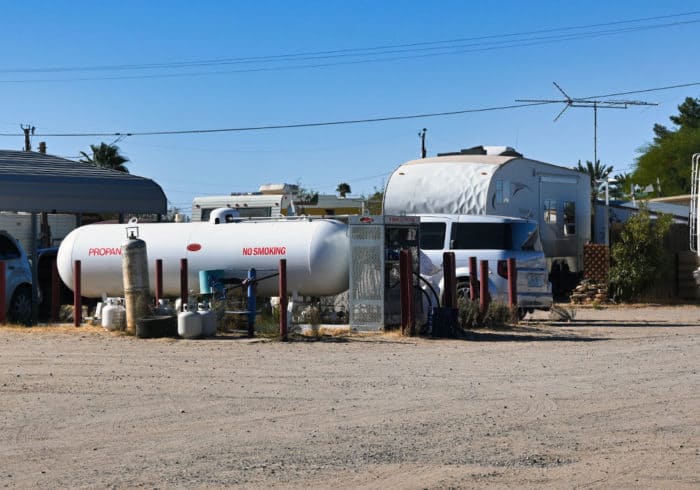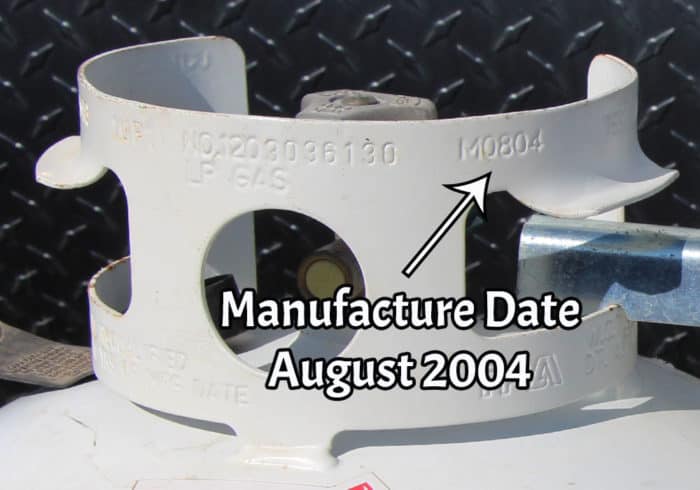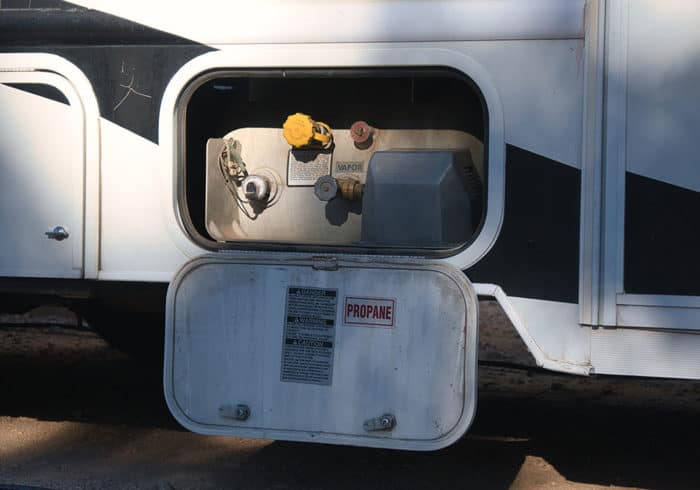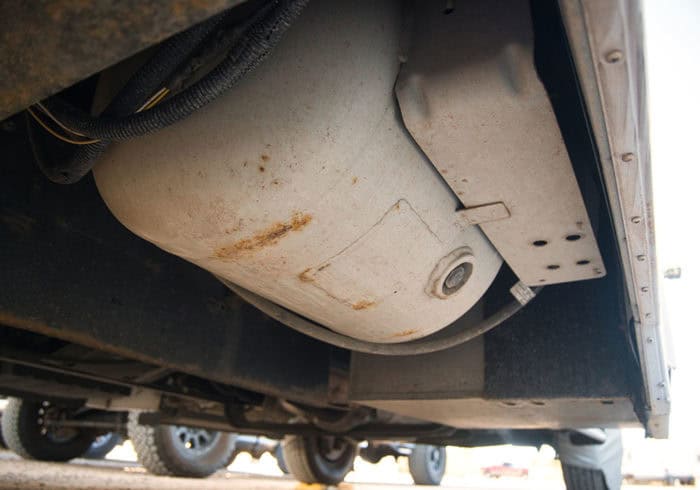What Is Propane Tank Recertification
Today we are going to be talking about the kind of propane tanks that are used by RVers and campers.
Portable propane tanks like the 20 and 30 lb tanks on the front of your travel trailer or connected to the grill are known as DOT cylinders (Department of Transportation).
Because they are meant to be transported and carried around.
Related Product: Home Propane Detector/ (click links to view on Amazon)
Because propane is a highly flammable liquid and gas that’s stored at a high pressure the Department of Transportation requires all portable propane tanks to be recertified periodically in order to make sure tanks that are being used out on the road are safe.
Motorhomes with permanently installed propane tanks are a little different since they can’t be taken out. You can read more about those in the ASME tanks section below.
So what is propane tank recertification?
In a nutshell, it’s basically taking your propane tank to a company that does propane tank recertification. And having them do an inspection.
During the propane tank inspection, they will look for things like any damage to the cylinder or welds like dents, cracks, rust, pitting, or fire damage.
Things like a missing foot ring, collar, or valve cover are also looked for.
The valve is also tested for leaks or any kind of defects in the pressure release.
Depending on what other methods were used to inspect the propane tank it will be recertified for anywhere from 5 to 10 years.
For more information and answers to common propane tank recertification questions check out the rest of this article. You can navigate using the table below.
RV Life Hack: How To Check How Much Propane You Have Left
How To Recertify A Propane Tank
Find A Propane Provider
The hardest part about getting a propane tank recertified is finding a place that will do it.
Your local hardware store or gas station that refills bottles probably doesn’t have the ability to recertify a propane tank.
But many propane providers who install tanks and deliver propane often have the means to recertify.
Companies like AmeriGas are all over the US and are easy to find. Just make sure you call the local office to set up a time with them since propane tank recertification can take a while.
Swap Your Propane Tank
Another way you can get your old propane tank recertified that I actually recommend over trying to find a provider that can get it done is to simply do a propane tank swap.
When you swap a propane tank you are going to get one that’s either new or has been recertified recently.
There are propane tank swaps all over the place, even at small businesses and grocery stores.
Most swaps that you see outside of stores are for smaller 20 lb grill tanks but there are places that trade even larger 30 lb propane tanks.
I’ve been able to swap a 30 lb propane tank at local hardware stores and propane providers.
In fact, when calling to get a tank recertified they recommended just swapping it with one that they had recently certified.
I didn’t need to make an appointment and the swap took only a few minutes.
See Also: What Does Oil In An RV Propane Regulator Mean? + How To Fix

Finding Propane Tank Certification Near Me
Since not all businesses that sell propane can do propane tank certification you are going to need to find a propane company that specializes in propane.
You can do a quick google search or check the local yellow pages to find propane services near you.
Make sure you call first to make sure they actually do recertification or to see if they can swap out your old propane tanks with recently recertified ones.
How To Tell If A Propane Tank Needs To Be Recertified
Safety is the most important thing when it comes to portable propane tanks and checking your tanks regularly to make sure they are in good shape is the first thing you should be doing.
A DOT propane tank that has lost the ring on the bottom or the collar on the top will need to be fixed and recertified.
Also if there are any dents or damage to the body of the tank you might want to have it checked just in case.
If the tank is in good condition the easiest way to tell if certification is about to expire is to check the numbers stamped onto the outside of the collar. (The ring that protects the valve on top.)

Manufacturing Date
There will be a lot of numbers on the collar, each means something different but the first thing you should look for is the manufacturing date which is normally 4 numbers.
It’s just a month followed by the last two numbers in the year.
For example, a propane tank made a few years ago might have 0318 stamped on it. That means it was made in March 2018.
Since the cylinder isn’t old enough to have needed recertification you won’t have to worry about it until 10 years from that date which would be March 2028.
See Also: Best Small Portable Propane Heater For Indoor & RV Use
Propane Tank Recertification Stamp
If the tank has been recertified there will be a requalification marking on the collar as well.
There are 3 certified ways to stamp recertification depending on how the recertification was done and by who.

In the graphic above there are examples of two of the three different recertification codes that consist of numbers and letters.
The first two numbers represent the month the recertification took place. In this case, it was March.
The next part A 1 2 3 is an example of a RIN (Requalifier Identification Number).
It’s the number the certified professional was given and it’s how they can be identified if needed.
The next two numbers indicate the year. In this case, it was 2018.
If there are no markings after the code the propane tank recertification type was a Volumetric Expansion test and the tank is good for another 10 years past the recertification date.
If there is an “E” or an “S” after the year code, like in example 2. Then a different test was performed.
The “E” indicates an “External Visual Test” which means the propane tank certification is only good for 5 years.
An “S” indicates a “Proof-Pressure Test” which means the tank will be certified for another 10 years.
In Example 2, the test done was external which means the propane tank is only certified for another 5 years.
The next graphic indicated the 3rd kind of recertification code you will find on a propane tank.

This code is used for external visual inspections which are only good for 5 years.
The V followed by 6 numbers is the “Visual Identification Number” of the person who inspected the tank.
The next four numbers are the month and year the inspection was done.
In this example, the inspection was done in March 2018.
The “E” at the end means “External Visual Method.”
That about sums up how to tell if a propane tank needs to be recertified.
You can read more in depth about what the different methods are later in this article but the most important things to find are the date the propane tank recertification was done and the method used.
If there’s an “E” at the end of either style of marking, you know that your tank is only good for 5 years from the date.
See Also: Best Portable Propane Tabletop Grills & BBQs For Camping
How Much Does Propane Tank Recertification Cost?
DOT propane tank recertification usually costs around $40 – $60 depending on what kind of method was used.
External visual inspections are normally cheaper.
If the valve on the propane tank was replaced this may increase the price.
New Propane Tanks vs Recertified Propane Tanks
A new portable or DOT propane tank is normally certified for 10-12 years. They’re nice because there’s no rust or dings to worry about yet but they aren’t very budget friendly.
You can get new propane tanks in stores or online (click here to view 20 lb tank on Amazon) or (click here to view 30 lb tank on Amazon).
Recertified propane tanks have been inspected and are just as safe as new propane tanks. They can be good for 5-10 years and often have new valves.
Swapping your old propane tank for a recertified one is the recommended way to go or you can get your old propane tank recertified by a certified inspector.
See Also: Our Review Of The Outland Firebowl Propane Fire Pit
Propane Tank Inspection
I talked about the different stamps on propane tanks that show the different kinds of methods used when inspecting propane tanks for recertification.
Here are the 3 different kinds of methods with an explanation for what they are and how long the certification is good for.
Volumetric Expansion Method
The Volumetric Expansion test is the most rigorous test a portable propane tank can go through.
The test is done using a “water jacket” for “hydrostatic testing.” A hydrostatic test will test the strength of the propane tank as well as check for any leaks or weak points.
The test is done by filling the propane tank with water that is pressurized 2x the normal amount.
The tank is then put in a water tank to displace the pressure and make it easier to see if there are any leaks.
If a volumetric test is done when recertifiying a propane tank the certification will last for 10 years.
Proof-Pressure Method
The proof-pressure test is similar to the volumetric expansion test but instead of water, air is being used to pressurize the tank to check for any weak points or leaks.
During this test the propane tank will be filled with air to a level that is 2X the normal pressure amount.
If the cylinder can handle the double pressure and there are no leaks the recertification will be good for 10 years.
External Visual Method
Finally, the simplest test that can be done to recertify a propane tank is the external visual test.
This is normally only done on propane tanks that appear to be in excellent condition and have no rust or scratches on the cylinder.
During an external visual test, a certified inspector will look for any damage including; bulges, rust, cracks, damage to welds, heat damage, or fire marks.
They will also pay close attention to any kind of corrosion like rust or pitting. They will even look at the areas around the foot ring and collar.
Any DOT approved propane tank must have a foot ring, a collar, and a valve cover.
The valve will also be checked for any defects or issues with the pressure relief valve.
If the valve is an issue the company doing the recertification can normally replace it for a fee.
An external visual test will only certify the tank for 5 years.
Propane Tank Recertification Sticker
When certain recertification methods are done, like an External Visual Test the certified inspector doesn’t always have the ability to stamp the metal on the collar.
In this case, a sticker is used instead of a stamp.
A propane tank recertification sticker will have the license number of the inspector followed by the month and year the certification was done.
The date is normally followed by an “E” which is the code used to indicate an external visual inspection.
If your propane tank has one of these stickers the certification is only good for 5 years after the inspection date.
Do not remove any stickers on propane tanks as they often show recertification.
See Also: How To Change An Automatic 2-Stage Dual RV Propane Regulator
What Are The Different Kinds Of Propane Tanks?
There are lots of different kinds of propane tanks out there. You have the great big ones that sit outside of homes or businesses that are used for heating and gas stoves.
Or you have the kind that can be transported around. The portable kinds are what we have mostly focused on in this article.
For campers, there are two main kinds. You have the DOT propane tanks that we’ve covered pretty well already. They’re your 20 and 30 lb tanks you can carry around.

ASME Propane Tanks
The second kind of propane tank you will find on a camper is the built in kind. These are normally found on motorhomes and vans.
A built in propane tank on a vehicle must be ASME (American Society Of Mechanical Engineers) certified. Because of the certification permanent install RV propane tanks are commonly referred to as ASME tanks.
An ASME propane tank (click to view on Amazon) has the same purpose as a DOT tank but there are a few key differences.
An ASME propane tank is built with thicker steel and welds. They are heavier than DOT tanks and they aren’t made to be carried around.
The biggest difference and benefit of an ASME propane tank is there is no recertification required after the initial manufacturing certification.
You should still do a visual inspection often and check for any damage to the tank to make sure it’s in safe working condition with no leaks but otherwise, there is no need to take it to a propane supplier to be recertified.
The reason for this is the thicker materials used and the fact that the propane tank is never being carried or moved around by anything other than the vehicle it’s mounted to.

It does seem a little strange since permanently mounted propane tanks on motorhomes are often exposed under the vehicle.
They take their fair share of rocks, water, and road salt but there is no law requiring them to be recertified.
See Also: Can RV Propane Lines Or Propane Regulators Freeze?
Getting A New Valve On A Propane Tank
A big part of propane tank recertification is checking the valve, and these valves aren’t as simple as they might seem.
In addition to the knob you turn to turn on or off the propane there is also a pressure relief valve on the back.
It’s there to release pressure in case the tank is overfilled and the gas inside expands past safe pressure levels.
There’s also an emergency shut off inside the valve that will stop the flow of propane from the tank if it detects an unregulated pressure release.
This safety feature is the reason you can’t just open a propane tank to release the gas without a regulator or hose attached.
If this ever happens to you the emergency valve can be reset by turning off the main valve and waiting for a few minutes.
The emergency shut off can sometimes be accidentally engaged if the propane tank is opened too quickly.
That’s why it’s recommended to open a propane tank slowly even when it’s connected to something like a grill or RV.
See Also: Is It Ok To Leave The RV Fridge On Propane While Driving?
Because of the complicated nature of propane tank valves and the need for them to be installed properly to withstand high pressure and be leak free I don’t recommend replacing the valve yourself.
Luckily most propane companies will replace propane valves and even recertify the tank at the same time.
It normally costs around $50. The cost usually covers a new valve, installation, and sometimes even a propane refill.
It’s the safest way to go and most towns have a propane provider that has this as part of their services.
Have any more questions about propane tank recertification? Leave a comment below.


I exchanged 2 empty 20lb tanks for amerigas 20lb tanks and the amerigas tanks both show expired mfg date and I did not see any recertification stickers? Are they legal?
Hi Kevin,
According to DOT standards, they aren’t legal to be transported or refilled until they are recertified.
Amerigas is usually pretty good about not giving out expired tanks though. I would contact them so they can fix the issue.
no there not they do not recertify 30 or 40 lbs tanks!!! they wont do 20 lbs eather
My house burned down due to a leaking propane tank on July 17, 2021. Five months after the fire I found a fragment of the propane tank collar. The date of manufacture was 08 02 and the identification code was clearly visible. How can I find out if this tank was ever re-certified and if so, who performed the re-certification.
Hi Joel,
Sorry to hear about your house. If you can find the part of the collar where a recertification stamp could have been placed you may be able to track down the person using the inspection number if there was a visual inspection done.
You can look at the examples under the recertification stamp section in the article to get an idea of what the code should look like.
Unfortunately, another common way to show propane tank recertification is to put a sticker on the collar or tank, and that may not have survived the fire.
If you can find that information I believe the people who could help you find the right person would be the Department of Transportation since they are the ones who are in charge of portable propane tank certification. They may also know of other ways to tell if a propane tank was ever recertified using the ID code.
Hi, I have a 100lb tank (I think, please tell me) it is about 4 ft tall, clear of rust and used for my grill only. It’s kept 40 ft from our home. Marking on collar is 10-17 which I assume is October, 2017 manufacture date. With summer heat in Arizona we have lost all stickers (providers and certification). We do not have any certification records. So how often does a tank this size need to be recertified? Are certification records kept somewhere that I can check? Is there a charge to decertify and who does it? I certainly appreciate your help, regards Paul Ps would you like me to send you picture of collar?
Hi Paul,
It does sound like you have a 100lb propane tank.
I’m pretty sure you’re correct about the 10-17 meaning it was manufactured in 2017.
100lb propane tanks are usually good for 10 to 12 years from the manufacture date, so you have a lot of time left before you need to worry. Especially if it’s free of rust and looks like it’s in good shape.
The next time you get it refilled you can ask the propane provider when they think it should be recertified. Usually, propane sellers also have the ability to recertify propane tanks for around $50-$75. Or if you do a propane tank swap you should get a newly certified propane tank back.
But based on what I know, the certification should be good until October 2027.
Do Rv propane tanks have to be recertified and if so how often. I had mine recertified in 2018 but I was told the rules changed in 2021 and it doesn’t have to be recertified again, is this correct?
Thanks
jim
Hi Jim,
Depends on the kind of RV propane tank. If you have an onboard propane tank that’s permanently mounted to your RV it doesn’t need to be recertified.
But if it’s a portable propane tank the recertification will last anywhere from 5 to 10 years depending on the kind of inspection that was done on it.
If recertification date stamp or sticker has an “E” after it, that means an external inspection was done on it and the recertification is for 5 years.
The DOT still has those rules posted on their website, so I don’t think any changes have been made.
You can go to this website for more information.
I have a 5th wheel RV permanently set up on a lot and I have a few DOT 7 Gal tanks that have been re-certified. However, I also have a couple of what looks like 100 lb tanks that are older, Stamped ICC 4B-XXX and dated 1947 and 1969. Both tanks have a metal screw cap but no collar. The 1947 tank has a worn, unreadable recertification sticker by a company no longer in business. The other one does not. These are much heavier than the typical DOT 100lb tank. Do these ICC tanks require recertification?
Hi Tim,
I think so. You should contact your local propane supplier and see if they will trade them for newer, certified 100lb propane tanks.
hello I’m looking to get two tanks recertified off the front of a trailer local I live in Arizona Phoenix
Vern Lewis welding supply will do it for you. They have about five sites in phoenix not all sites recertify.
In the How To Re-certify A Propane Tank section you have the following statement:
Companies like AmeriGas are all over the US and are easy to find. Just make sure you call the local office to set up a time with them since propane tank recertification can take a while.
For what it’s worth AmeriGas tells me that they have closed all their local offices in the U.S.. Luckily for me someone suggested that I call the welding shops that use propane to find out who they use for certifying their tanks. Following that path proved to be successful.
Hi Emory,
Thanks for the update about AmeriGas. I like the idea of calling local welding shops to find out who they use for recertification. Good advice is always welcome, thanks.
I have a van with a permanent propane tank that I would actually like to empty – what’s the best way to safely empty a tank?
Hi JP,
I think using up the propane with a propane appliance is probably the easiest way to go.
I something like a propane heater, grill, or stove should use it up pretty quickly.
Thank you for this article. There’s a lot of wrong information out there about the need to recertify permanently installed ASME propane tanks in motorhomes. We’re starting to be told at refill stations that we need to have ours recertified. Can you point me to the actual regulations? I’d like to carry a copy to avoid being turned away in the future and to educate technicians. Thanks.
Hi Steve,
You can find propane tank recertification regulations here.
There are some cases where recertification might be required for an ASME propane tank if it meets the criteria found here.
Looking for help identifying this tank and confirming the expiration date and date of inspection the indicator that I have is
08AC318E
Hi Terry,
Looks like your tank had a visual inspection in August 2018, the certification is good for 5 years.
That means you will need to get it recertified or trade it in for a recently certified tank in August 2023, so the end of the summer this year.
I just bought a house. Ameri gas said tank ownership is transferred, per Florida law. How do I verify this. I didn’t sign anything and Ameri gas is no help
I have a 10lb tank that was given to me. It’s in very good visual shape, but the manufacture date is 3 / 07 with no signs of ever being recertified. So does that mean it CAN NOT BE RECERTIFIED or is it still possible though a company that preforms the testing ?
Thanks,
Jcristensen
Hi Jon,
It can be recertified, or you can swap it for a certified one.
Can a 100 lb propane tank be re-certified if there is still gas in it? The visual inspection shows it to be in good condition.
Hi Bob,
Yes, you should be able to get it recertified with gas still in it.